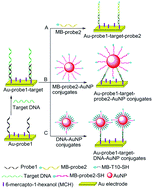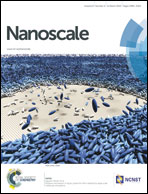Amplified detection of femtomolar DNA based on a one-to-few recognition reaction between DNA–Au conjugate and target DNA†
Abstract
A sensitive electrochemical DNA biosensor based on the amplification of Au nanoparticles (AuNPs) has been developed. The AuNPs were modified with two types of signaling reporter DNAs, i.e. a methylene blue probe (MB-probe 2-SH) and T10 with a methylene blue signaling molecule (MB-T10-SH), forming DNA–AuNP conjugates. The MB-probe 2-SH is complementary to the target DNA, while MB-T10-SH is not. The presence of MB-T10-SH reduces the cross-reaction between target DNA and MB-probe 2-SH on the AuNPs, resulting in increased sensitivity of the biosensor. In our assay, the DNA sensor is fabricated by immobilizing a capture probe on the surface of the Au electrode, which then hybridizes with the corresponding target DNA, and further hybridizes with a DNA–Au conjugate. The signal of MB is measured by differential pulse voltammetry, while the DNA–Au conjugate enables the detection of target DNA in the linear range of 10−13 to 10−8 M with the detection limit as low as 50 fM.


 Please wait while we load your content...
Please wait while we load your content...